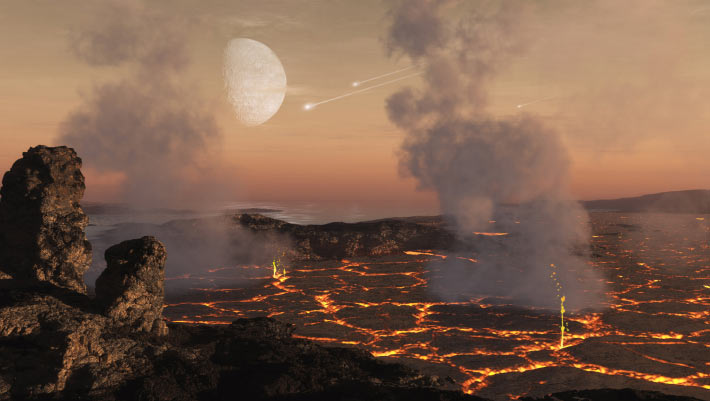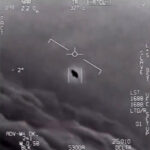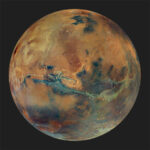Precursors of the molecules needed for the origin of life may have been generated by chemical reactions promoted by meteoritic and volcanic particles approximately 4.4 billion years ago, says a team of researchers led by Professor Oliver Trapp from the Ludwig-Maximilians-Universität München.
An artist’s impression of the Hadean Earth: huge, impact-generated lava lakes coexisted with surface liquid water, under a thick greenhouse atmosphere sustained by lava outgassing. Image credit: Simone Marchi & Dan Durda, Southwest Research Institute.
“The formation of reactive organic molecules to form the building blocks of life on the nascent Earth is one of the prerequisites for abiogenesis,” Professor Trapp and colleagues said.
“The emergence of a stable continental crust and liquid water on the Earth at 4.4 billion years ago, and the earliest biogenic carbon isotope signatures at 3.8-4.1 billion years ago suggest that life originated only 400-700 million years after the formation of the Earth.”
“This relatively short time span indicates that the major part of organic precursors has been already formed on the Hadean Earth as early as 4.4 billion years ago.”
“One possibility is that the prebiotic organic constituents that had been formed in the solar nebula, carbon-rich asteroids, and comets have been delivered onto the early Earth,” they said.
“Other theories consider the synthesis in the atmosphere and in the ocean by catalytic or high energy processes (lightning, volcanic energy, impact shocks).”

Formation of prebiotic key organic matter from carbon dioxide by catalysis with meteoritic and volcanic particles. Image credit: Peters et al., doi: 10.1038/s41598-023-33741-8.
In their study, the authors investigated whether meteorite or ash particles deposited on volcanic islands could have promoted the conversion of atmospheric carbon dioxide to the precursors of organic molecules on the early Earth.
They simulated a range of conditions that previous research has suggested may have been present on the early Earth by placing carbon dioxide gas in a heated and pressurized system — an autoclave — under pressures ranging between 9 and 45 bars and temperatures between 150 and 300 degrees Celsius.
They also simulated wet and dry climate conditions by adding either hydrogen gas or water to the system.
They mimicked the depositing of meteorite or ash particles on volcanic islands by adding different combinations of crushed samples of iron meteorites, stony meteorites, or volcanic ash into the system, as well as minerals that may have been present in the early Earth and are found in either the Earth’s crust, meteorites, or asteroids.
The scientists found that the iron-rich particles from meteorites and volcanic ash promoted the conversion of carbon dioxide into hydrocarbons, aldehydes and alcohols across a range of atmosphere and climate conditions that may have been present in the early Earth.
They observed that aldehydes and alcohols formed at lower temperatures while hydrocarbons formed at 300 degrees Celsius.
“As the early Earth’s atmosphere cooled over time, the production of alcohols and aldehydes may have increased,” they said.
“These compounds may then have participated in further reactions that could have led to the formation of carbohydrates, lipids, sugars, amino acids, DNA, and RNA.”
“By calculating the rate of the reactions they observed and using data from previous research on the conditions of the early Earth, we estimate that their proposed mechanism could have synthesized up to 600,000 tons of organic precursors per year across the early Earth.”
“Their mechanism may have contributed to the origins of life on Earth, in combination with other reactions in the early Earth’s atmosphere and oceans.”
The findings appear in the journal Scientific Reports.
_____
S. Peters et al. 2023. Synthesis of prebiotic organics from CO2 by catalysis with meteoritic and volcanic particles. Sci Rep 13, 6843; doi: 10.1038/s41598-023-33741-8




